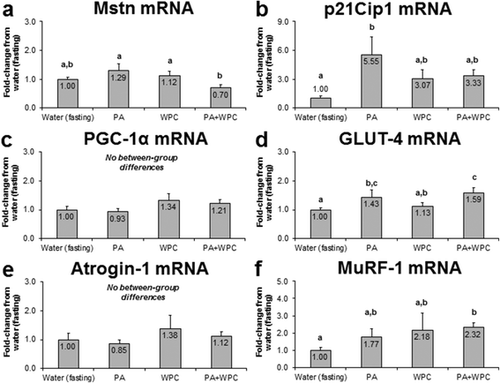Figures & data
Fig. 1 Effects of PA with or without the co-ingestion of WPC on mTOR signaling markers. Legend: Data are presented as means ± standard error, and bars not sharing similar superscript letters are significantly different (p < 0.05) as determined by one-way ANOVAs with protected LSD post hoc comparisons. CON n-size = 13, PA, WPC, and PA + WPC n-sizes = 7–8. Panels a–e: Effects of each ingredient on upstream positive modulators of protein synthesis. Panel f: representative digital images select phospho-targets that were altered with feedings
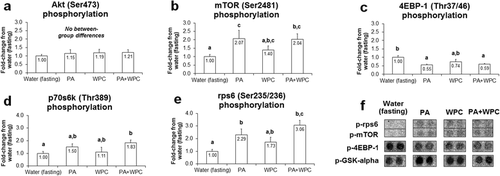
Fig. 2 Effects of PA with or without the co-ingestion of WPC on other intramuscular signaling markers. Legend: Data are presented as means ± standard error. Bars not sharing similar superscript letters are significantly different (p < 0.05) as determined by one-way ANOVAs with protected LSD post hoc comparisons. CON n-size = 13, PA, WPC, and PA + WPC n-sizes = 7–8. Panel a: Effects of each ingredient on AMPK-α phosphorylation 3 h post-ingestion (cellular energy sensor; more phosphorylation is related to decreased mTOR pathway activation). Panel b: Effects of each ingredient on Erk-1/2 phosphorylation 3 h post-ingestion (positive upstream modulator of protein synthesis). Panel c: Effects of each ingredient on PDK1 phosphorylation 3 h post-ingestion (upstream modulator of protein synthesis). Panel d & e: Effects of each ingredient on GSK-3α/β phosphorylation 3 h post-ingestion (upstream modulator of protein synthesis). Panel f: Effects of each ingredient on PRAS40 phosphorylation 3 h post-ingestion (negative upstream modulator of protein synthesis)
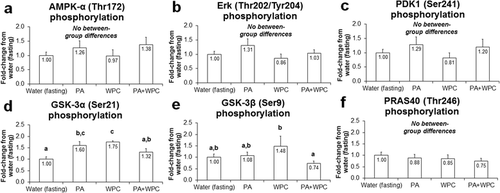
Fig. 3 Effects of PA with or without the co-ingestion of WPC on 3 h post-feeding MPS. Legend: Data are presented as means ± standard error, and bars not sharing similar superscript letters are significantly different (p < 0.05) as determined by one-way ANOVAs with protected LSD post hoc comparisons. CON, PA, WPC, and PA + WPC n-sizes = 6–8. Panel a: Effects of each treatment on 3 h post-feeding MPS levels. Panel b: Representative image of the SUnSET blot. PA, WPC, and PA + WPC all significantly increased MPS levels compared to fasting conditions
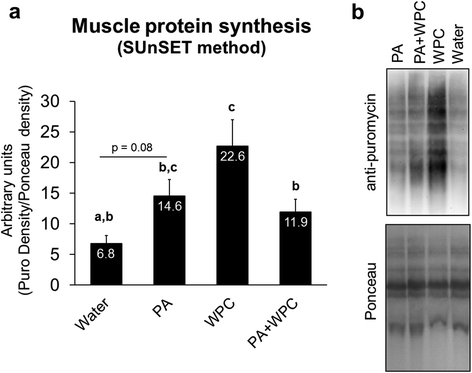
Fig. 4 PA increases C2C12 myoblast mTOR signaling and MPS. Legend: Data are presented as means ± standard error. All data were obtained from 2–3 independent experiments (n = 6–11 wells per condition). Significant between-treatment differences (p < 0.001) existed for p-p70s6k (Thr389) and MPS levels as determined by independent samples t-tests (denoted by different superscript letters). Panel a: C2C12 myoblasts were serum starved for 18 h and then stimulated for 30 min with 30 μM PA, or PBS as a control condition. Measurements of mTOR signaling were assessed by evaluating the phospho to total ratio (P:T) for p-p70s6k (Thr389) and total p70S6k. Panel b: C2C12 myoblasts were treated as described in panel a and measurements of protein synthesis were performed by assessing puromycin incorporation during the final 30 min of a 60 min stimulation period. The Western blot membranes were stained with Coomassie Blue to verify equal loading of protein in all lanes
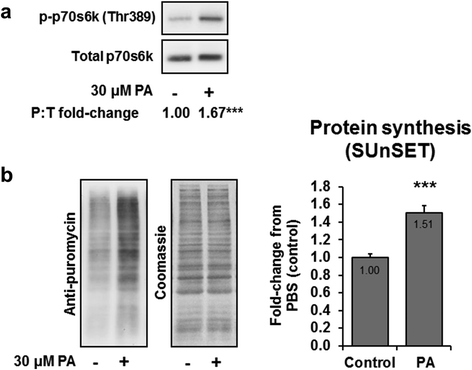
Fig. 5 Effects of PA with or without the co-ingestion of WPC on skeletal muscle mRNA expression patterns. Legend: Data are presented as means ± standard error. Bars not sharing similar superscript letters are significantly different (p < 0.05) as determined by one-way ANOVAs with protected LSD post hoc comparisons. CON n-size = 13, PA, WPC, and PA + WPC n-sizes = 7–8. Panels a & b: Genes linked to skeletal muscle hypertrophy. Panels c & d: Genes linked to skeletal muscle metabolism. Panels e & f: Genes linked to skeletal muscle atrophy (Atrogin-1) and remodeling (MuRF-1)
